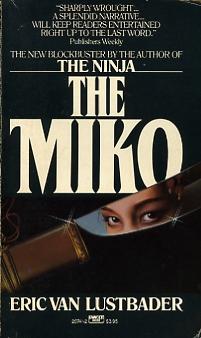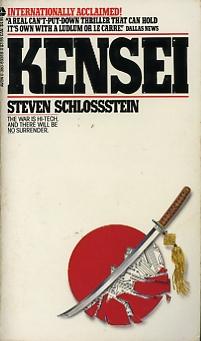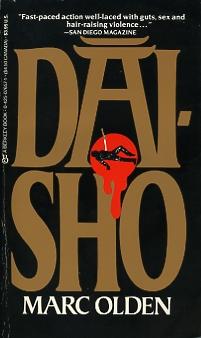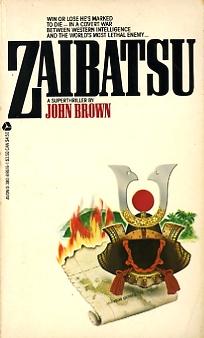'Japanese peril' revived in popular novels
By William Wetherall
A review of four novels
John Brown, Zaibatsu, 1983
Eric van Lustbader, The Miko, 1984
Marc Olden, Dai-Sho, 1983
Steven Schlossstein, Kensei, 1983
A version of this article appeared in
The Japan Times, 29 June 1985, page 7
A substantially revised and shortened version of this article appeared in Far Eastern Economic Review, Vol. 129, No. 30, 1 August 1985, pages 41-42. Though the version written for FEER was similarly titled "Japanese peril" revived in recent popular novels, FEER retitled it Paranoia invents the rebirth of the Yellow Peril, which exaggerates the scope of the paranoia in most of the reviewed stories.
Kaiser Wilhelm II's gelbe gefahr expressed his fear that China would someday overrun Europe like the Mongols had conquered most of Asia. The classic "yellow peril" in popular English fiction was master-of-villainy Sax Rohmer's insidiously British Dr. Fu Manchu, who first threatened the white world in 1913 and kept trying until his creator's demise in l959.
From the Russo-Japanese war in 1904-1905 to 1945, however, many Americans considered Japan the main Asian threat to white dominance. The Chinese communist revolution, and the Korean and Vietnamese wars, shifted the occident's oriental phobia back to China. But trade imbalances and hi-tech rivalries have swung it to Japan again.
Today the "Japanese peril" is a genre in and of itself among the numerous entertainment novels in English with an Asian connection. Hundreds have appeared in the past decade, many of them in hard cover before coming out as paperbacks.
All of the four books introduced here reflect the growing concern with Japan in Europe, the Americas, and Pacific Asia. They are all good escapes for readers with time to kill and a willingness to overlook their flaws as stories and ethnographies.
The Miko and Dai-Sho depend the most on exotic fantasy and erotic violence to carry their commonplace plots. They are also the most successful commercially (especially The Miko, which has made a number of bestseller lists), ostensibly because their authors are the most experienced and write with the most flare.
The Miko and Kensei attempt much more than the other two books to double as Japan travel guides. Neither succeeds, but least of all Kensei, though its author was the most pretentious in his effort to lecture on Japanese culture and personality, and its publisher boasts the most about the author's dubious qualifications.
What makes the four novels important, both as mirrors and movers of public opinion, is the common manner in which Japan's conglomerates are depicted as frightening, not so much because they are huge as because they are run by bushido chauvinists who believe that Japan is superior to other countries. David wins, but goes through life looking over his shoulder, wondering when Goliath -- like Fu Manchu and Godzilla (Japan's perennial "alien peril") -- will return or have kids.

Eric van Lustbader The "half-Caucasian, half-Oriental" hero of The Ninja (1980) returns in this 1984 novel to save Japan and America from the evils of Soviet communism. On the visible top soil, a US hi-tech firm with the "goods" wants to merge with a Japanese competitor with the "wherewithal" to produce the non-volatile RAM chips (what else?) at the right price. The "half-breed" hero, as the bilingual and bicultural mediator for the U.S. side, tries to coach his bull-headed boss in the finer arts of tiptoeing through the non-tariff minefields. In a patriotic ninja master's vault are plans for Tenchi, a super-secret project that would make Japan forever independent of both the U.S. and the U.S.S.R. The intelligence agencies of both countries (and China) are on to it, of course, and their spies will stop at nothing to learn the details, induce a miscarriage, and thus keep Japan under their thumbs. At the very deepest stratum is a sensual and vicious female ninja (the miko) who is bent on avenging the deaths of her father and husband, which she blames on the hero. Her only problem is that she loves him too. Lustbader has characteristically padded his story with horrible killings and ritual suicides galore. Hard-core sex waxes when the blood -letting wanes. And between the moans and groans of cathartic pain and pleasure are lulls of language lessons cribbed from misconsulted Japanese-English dictionaries, and encyclopedic but often distorted digressions on everything from Japanese history, psychology, and the political bureaucracy to the gay quarters, street addresses, and the meaning of death. If the novel has a message, it is the too familiar notion that a non -Asian needs at least a drop of Asian blood in the veins to really understand and get along with Asians. Its most original contribution to the occidental stereotype of oriental character is that giri (duty) and karma (fate) take a backseat to wa (harmony) as the prime spiritual mover. |

Steven Schlossstein A cleancut super-nice blue-eyed squash player with a ready smile is pitted against an ever-scowling chain-smoking corporate-samurai fanatic who is bent on conquering the inferior non-Yamato world or die trying. At stake are all the familiar necessities of life -- honor and glory, miracle microchips, a PhD doll to enlighten the hero when she's not turning him on, and a plastic prostitute for the bad guy to punish. Kakuei Tanaka of Lockheed scandal fame is back as Prime Minister and "in a position to fulfill his promise to . . . put Japan in a position of global power!" A Ministry of International Trade and Industry bureau chief, a Self-Defense Forces major, and the head of the planning division of "the largest industrial conglomerate in postwar Japan" believe that Japan is destined to be the "sensei" (teacher, master) rather than the "deshi"(apprentice, disciple) of the US and the USSR. All middle-aged products of the elitist University of Tokyo, the trio is out to make Japan militarily powerful enough to be able to refuse to renew the Security Treaty with America and force the Soviet Union to return the Kurile islands by 15 May 1985. If not, they will atomize twelve major cities around the world, including Tokyo. But the Japanese are unable to develop the "256K optical chips" needed to guide the multiple warheads that they have secretly developed. So some are stolen from the good guy's Silicon Valley plant, by a Japanese disguised as a Vietnamese refugee janitor. All Asians look alike. Schlossstein, unlike Lustbader, is as close to being a Japanologist as one can get and still be human. The villain embodies all that the author seems to have found most hatable about the Japanese men he met ( or imagined were laughing at him) during his many years in Japan as a graduate student and financial company executive. Schlossstein -- the author of the more entertaining Trade War: Greed, Power and Industrial Policy on Opposite Sides of the Pacific (St. Martin's Press, 1984) -- may have been to the mountain, but he brought back the wrong tablets. Like the last word in the extensive Japanese-English glossary at the end, his racist stereotypes and cultural fabrications (Japanese do not carry a "National Identity Card" with their picture, thumb print, criminal record, etc.) are simply "zannen" (unfortunate, too bad). |

Marc Olden DiPalma, an ex-New York cop with a slight limp and a mean cane, takes on the demented might of a Japanese industrial-espionage group run by Nosaka, a wealthy industrialist and a power among the zaikai, Japan's big business interests. A convicted war criminal who beat the hangman, Nosaka helped found the Blood Oath League, which he has built into "one of Japan's most efficient terrorist and espionage units" with the help of "unlimited funds from right-wing businessmen." Nosaka's lover and disciple is Kenpachi, "Japan's most famous and controversial film director" cum jack-of-all-arts and cult hero of homosexuals, the young, and yakuza gangsters. Kenpachi plans to commit seppuku when he finishes his film masterpiece, to be produced by Jan, an American woman who wants Kenpachi but needs DiPalma. The second who will lop off Kenpachi's head is DiPalma's ll-year-old son by the daughter of a Hong Kong triad leader. The boy is possessed by the spirit of the most loyal samurai of the medieval lord who once owned the castle that Kenpachi now lives in. Before Kenpachi dies, he wants to kill certain men who he blames "for what Japan has become, a polluted and mercenary extension of the West." One of the marked is Jan's father, who prosecuted Nosaka in the war crimes tribunal. Nosaka is dimly modelled after the late Yoshio Kodama, the right-wing power broker of Lockheed scandal fame. Kenpachi is a much maligned cardboard copy of Yukio Mishima, the novelist who ritually disemboweled himself after finishing his life work and trying to incite a coup d'etat in 1970. Nosaka's worldwide dirty tricks have earned him the reputation of being "Japan's most effective spymaster" since medieval times. DiPalma, not a Japanologist, can't understand why the Tokyo government doesn't sanction his activities. An old Japan hand sets his mystified compatriot straight: industrial espionage "is not, repeat, not a crime" in Japan, but merely part of the country's defense. |

John Brown First published in Australia in 1983, this novel shifts the theater of Japanese design on the world to Southeast Asia. The hero, a New Guinean of Anglo-Australian ancestry residing in Switzerland, returns to New Guinea to look into the murder of his brother, who had stayed to manage the family's plantation. He suspects "the wealthiest and most powerful man in Japan", who is the head of a zaibatsu (conglomerate) that "doesn't have one particular company name, but [is] still the biggest of them all." An advertising blurb claims that the zaibatsu head "will sacrifice anything or anybody to the fanatic dream of a new Japanese empire," but this is not exactly true. Though he tries to cause uprisings, revolts, and coup d'etats in Indonesia and Papua New Guinea "to develop the resources of the resultant nation in an economic union with Japanese interests", the hero concludes that he is "too much of a man" to have murdered his brother. Following their own evil stars are a couple of Australian agents who bungle their attempts to disrupt the Japanese plans. For this they die deaths that are deservedly less glorious, honorable, or aesthetic than the seppuku (self-disembowelment) that the zaibatsu head commits, alone and in peace with himself on a stony ridge overlooking Port Moresby. He has been there before, during the war, when he met and found reason to deeply respect the hero's father. In striking contrast to the other three novels, sex in this one is faded in and out like in movies where the door is closed on the camera before things get out of hand. But the erotic is there in various exotic bloods pure and mixed -- Russian, Japanese, Ainu, Filipino, Dutch, Kiriwani, and just plain old "native". Zaibatsu has none of the vileness and hyperbole that mar Kensei, and little of the spiritual mysticism that makes The Miko and Dai-Sho almost unreadable. As a story, though, it is easily the least inspired of the four. But if it is relatively brief, simple, and boring, it also does less damage to the cause of understanding Japan. |